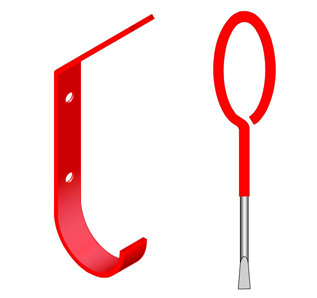This is an example of a description of one of our focused practical tasks. It gives students the learning objectives, the success criteria, a list of resources that they require and a list of things that they need to do to complete the focused paractical task. Our software contains HTML and PDF versions of this task. |
|
| |
|
|
Objectives
Students will develop their D&T capability by learning about what causes metals to rust and three methods of plastic coating metal products.
By the end of the assignment, students will know that:
- metals rust in the presence of air and water
- rusting can be prevented by excluding air or water (or air and water) from the surface of a clean metal
- a film of plastic covering a metal will exclude both water and air from the surface of a metal and therefore prevent rusting from occurring
- plastic coatings may be applied by
- dip coating in a fluidised bed of polymer powder
- dip coating in a bath of Plastisol
- flock spraying
- hot parts of ovens and heated metal and plastics will burn skin so:
- risk assessments of the hazards should be carried out
- safe working practices should be adopted
|
|
Success criteria
Each student:
- has designed and made an original product that satisfies the given design brief and specification
- has used tools safely and has strived to achieve quality in marking out, cutting, shaping, finishing and joining their chosen materials
- knows that thermoplastics can be softened by heating
- knows that line benders are used to heat (relatively) narrow areas of thermoplastic sheet materials
- knows that thermoplastics soften and can be bent when heated and become rigid again when cooled.
- knows that jigs may be used to:
- aid bending thermoplastics
- hold heated thermoplastics after line bending until the plastic is cool
- has assessed the risks associated with working with strip heaters and hot thermoplastics and has worked safely throughout the assignment
- shows evidence of having evaluated his/her work.
|
| |
|
|
Situation
Metals rust unless water and air are prevented from coming into contact with the metal. One way of preventing water and air from coming in contact with a metal is to plastic coat the metal. Plastic coating gives a thick, rubbery, water proof coating that if adhered to the metal properly, also prevents air from coming in contact with the metal.
Brief
Plastic coat a steel product, e.g. a coat hook or a screw driver made from a bent carbon steel rod, by either:
- dip coating the metal in a fluidised bed of polymer powder
- dip coating the metal in a bath of Plastisol.
|
|
|
| |
|
|
Resources Required
The following are the essential resources that you will need to complete this assignment:
- at least one steel product that will be plastic coated
- emery cloth to remove all rough edges and rust from steel
- a degreasing agent, (washing up liquid, Jif etc)
- an oven to heat steel the product
- a fluidising tank with polymer powder
- wire, tongs etc for holding the steel product
- Plastisol
|
|
What you must do
- Clean your steel product
- Heat your steel product to a temperature that will melt the polymer powder or Plastisol
- Plastic coat your steel product using either:
- a fluidised bed of polymer powder
- a tank of Plastisol
- Reheat your product to ensure that the polymer has melted throughout its thickness
- Prepare a Risk Assessment of the hazards involved with plastic coating
- Evaluate the final product, e.g.:
- how well the plastic coating has covered your steel product, checking for pin holes, unevenness, unmelted polymer.
- discover what others think about your product.
- Work safely and complete the assignment on time.
|
| |
|
|
